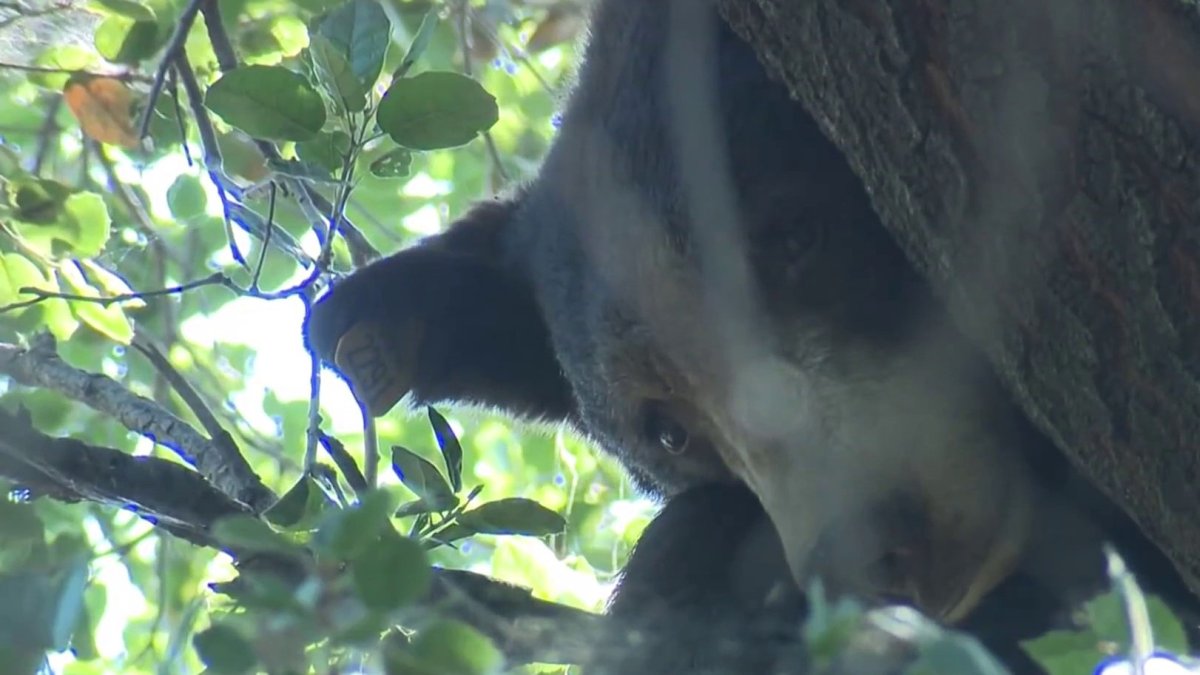A familiar face appeared in the Sylmar area over the weekend.
A bear captured several weeks ago in the foothills of the San Gabriel Mountains and taken down from a tree in Chatsworth on Tuesday was found hanging from another tree in the Sylmar area over the weekend. The bear, known to wildlife officials as Yellow 2291, was fitted with a tracking collar and eventually climbed down from the tree in the northern San Fernando Valley.
The bear is the same one that was spotted Tuesday south of the 118 Freeway in the Chatsworth area of the western San Fernando Valley. Video showed the bear climbing over a chain link fence and into a tall tree. The bear was tranquilized and put into the back of a pickup truck and taken back into the mountains, but it didn’t stay there for long, heading back down the mountains again a few days later toward Sylmar.
The female bear, between 3 and 5 years old, is no stranger to wildlife officials. State wildlife officials said she was captured in late May in the Claremont area, in the foothills of the San Gabriel Mountains, about 50 miles from Chatsworth, and taken to Angeles National Forest. Officials have been monitoring the bear since then, tracking her collared movements along the 210 Freeway and into the Malibu area.
“Her collar data is actually the most interesting we’ve ever seen,” Jessica West, an environmental scientist with the California Department of Fish and Wildlife, told NBCLA last week. “She’s just wandering around. It may be more common to see this behavior in male bears because, being males, they tend to have larger ranges.”
Before the bear showed up in Chatsworth, authorities had attempted to capture it in the Northridge area on July 1. After it was tranquilized, it tumbled out of the tree and landed on a mat provided by a nearby gym.
About California Bears
American black bears, which come in a variety of fur colors, enjoy eating plants, insects, nuts, berries, and anything else they think is edible (like the contents of trash cans). When food becomes scarce in their habitat, the bears will look elsewhere for food, likely leading them to the foothills of Southern California.
California’s black bear population has been on the rise over the past 20 years, from an estimated 10,000 to 15,000 in the early 1980s to 25,000 to 30,000, according to the California Department of Fish and Wildlife, but that’s a conservative estimate.
Known for their small, narrow heads and tiny ears, black bears have fur that ranges in color from tan or brown to black. Females can grow to weigh around 200 pounds, while males can reach 350 pounds, with some giant bears weighing over 600 pounds.
About half of the state’s bears live in the Sierra Nevada mountain range and areas north and west of it. West-central and southwestern California is estimated to be home to just 10 percent of the black bear population.
Despite being featured on the state flag, the fearsome grizzly bear is no longer seen in California’s wilds — the last grizzly bear observed in California was shot and killed in the early 1920s.

